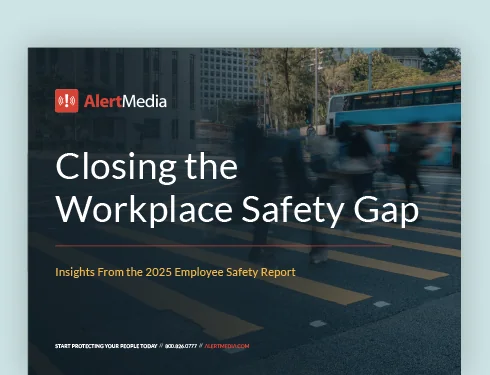
How a Lone Worker Safety Program Can Benefit Your Organization
Building out a comprehensive lone safety program and properly training your workers is a proactive measure every organization should take.

Employee safety is a top concern for any organization. Employers have a duty of care obligation to keep their people safe, and employees need peace of mind that their organization is not going to put them in harm’s way. For lone workers, the level of safety they feel has a direct impact on the likelihood they’ll stay with their current employer. According to HR firm Businessolver, 90% of employees are more likely to remain with a company that empathizes with their needs.
But first, a quick profile of who a lone worker is:
Which Industries Typically Employ Lone Workers?
Any business could feasibly employ lone workers—particularly if there is a field sales/technical component to their business. But statistically, lone workers tend to be most commonly found in the following industries and professions:
Industries
- Home Healthcare
- Real Estate
- Child & Protective Services (social services)
- Oil & Gas
- Service/Maintenance
- Manufacturing
- Transportation
- Any business where workers are on their own
Roles
- Social Workers
- Caseworkers
- Property Managers/Real Estate Agents
- Home Healthcare Workers
- Service/Maintenance Techs
- Construction Workers
- Drivers
Lone workers are typically out in the field with no direct supervision or work companion. As a result, they face unique threats that can put them at risk for work-related injuries.
Because of their isolation, risks are amplified. If your organization doesn’t have a reliable emergency communication system in place, your workers will feel vulnerable and exposed.
Fortunately, there are measures every business can take to give their people the level of comfort and safety they deserve. Developing an effective safety program centered around risks, roles, communication, and education is the surest way to safeguard employees, boost morale, and minimize turnover.
Build a Lone Worker Safety Action Program
Perhaps the most impactful step an organization can take in helping their lone workers feel safe with their current employer: developing a thorough lone worker safety program. Staying proactive is key to preparing your people for unexpected emergencies on the job.
In fact, a Johns Hopkins study showed that companies that have exemplary safety, health, and environmental programs outperform the S&P 500 by between 3 and 5 percent.
Here’s a breakdown of key actions that will help structure your program:
- Assess Risks: Fully understanding the dangers your people face is crucial to providing them with the tools necessary to keep them safe on the job.
- Outline Program: Once you’ve established the risks, it’s time to craft a program that clearly articulates your company’s emergency protocol.
- Invest in Communication Tools: You’ll want to adopt a reliable two-way emergency notification app to keep your lone workers safe, informed, and connected.
- Educate Your People: After identifying potential lone worker hazards, you need to determine who is at risk and properly train them on emergency procedures.
In addition, it’s important to check in with your people to ensure the program is working for them. The more they feel their employer is going the extra mile to ensure their safety, the less lone workers will feel stressed, anxious, and potentially seek new employment.
1. Risk assessment
Involving your workforce is a reassuring first step in determining what risks your lone workers face. This can include front-line workers and their supervisors who you can engage in small focus groups to gather feedback through surveys.
Another helpful exercise is to shadow your workers and observe how they conduct business in order to assess the risks they face. Looking at historical health and safety data (both by company and industry) is a useful way to identify patterns and specific areas of concern.
Taking the time to establish risks ahead of time will help ensure you develop a program that addresses the specific needs your lone workers face.
2. Outline the program
Once the risks have been established, it’s time to layout your organization’s rules and guidelines for working alone. As you construct your program, it’s important to develop a cross-functional team that will work together on relevant content.
Once your program is established, training your people across the board is essential in helping with your organization’s retention efforts. According to the Centers for Disease Control: “Providing training […] on reducing stressful working conditions can improve employee health, reduce turnover, and increase employee retention.”
Your program should cover the following:
- Purpose of the Program: If employees don’t understand the rationale behind your lone worker safety program, it’s going to be more difficult to roll out.
- Risks of Working Alone: Your program should capture all the potential hazards your lone workers face, such as a communications breakdown, so they know you’re fully invested in their safety.
- Lone Worker Definitions: Be clear on the various ways your organization defines lone workers so your people understand when and how policies apply to them.
- Roles and Responsibilities: When everyone understands the part they play (both employees and supervisors), your program will ultimately be more effective.
- Reporting Requirements: Define hazard and incident reporting guidelines to help reduce your organization’s legal risks and ensure employees have an avenue to get the support they need.
- Safety Standards: Inform your lone workers what actions they must take to protect their health and safety and the minimum standards expected of them.
- Resources: Summarize the help and support available to your people, which will provide them with an additional level of comfort.
Ultimately, your program should provide practical instruction on what lone workers, their supervisors, and the organization should do to keep everybody safe and connected. Keep in mind, the safety culture you’re fostering has a direct correlation to employee retention.
3. Communication
The backbone of a lone worker safety program is communication. Due to the isolated working conditions lone workers face, securing them with a reliable way to quickly signal for help is crucial to ensuring their safety and easing their concerns.
Traditional communication channels present a number of flaws, especially in the context of protecting lone workers. Even if they’re carrying their mobile devices, employees may not have access to their phones at all times. When your workers know you’ve equipped them with relevant tools, they feel an added level of satisfaction with their employment.
AlertMedia offers a hands-free lone worker solution that provides 24/7 monitoring and a direct connection to law enforcement when emergencies happen. Here’s how it works:
- Users install the app on their iOS or Android smartphone
- They begin a timed monitoring session in the app
- If the timed session expires or they press the panic button, an audible alarm is triggered
- AlertMedia’s monitoring staff immediately dispatches law enforcement to the worker’s location
Empowering your lone workers with an easily accessible alarm to quickly signal for help will give them the peace of mind they need to safely conduct their work.
You’ll also want to invest in an emergency communication system that comes with two-way messaging notifications so that both you and your people stay connected.
4. Education
A lone worker safety program is only as good as the people who know how to use it. In addition to educating your people on the specifics of your program, you should also assign roles and responsibilities during this phase.
Promote your program with regular webinars and training sessions. In terms of your communication tools, a quality provider will offer instructional videos to ease adoption. Any new tools will require some education. But integrating your communications solution should be quick and easy so you’re up and running within hours.
Another helpful best practice: include lone worker safety training and your company’s rules and regulations on working alone as part of the new hire onboarding process. This helps establish your level of concern for employee safety right out of the gate.
It’s important to involve workers and give them a reason to care about your organization’s overarching mission. According to occupational safety and health magazine EHS Today: “When employees are not committed or fully vested in safety culture, they’re not overly concerned with their performance and they are not invested in the future success of the company.”
Sending out regular reminders on your safety program and annual refresher training will keep lone worker policies top of mind and convey a clear message: your organization is committed to keeping its people safe.
Once your lone worker safety program is complete, it’s time to test equipment and run drills to ensure all components are functioning as they should. This is also an opportunity to seek feedback from your people to find out what policies are working and what might need improvement/adjustment.
Adopt an Emergency Communications Solution
Building out a comprehensive safety program and properly training your lone workers is a proactive measure. Every organization should make sure to implement one to keep their workers protected. And showing your people you truly care about their safety is one of the most impactful ways to secure their employment.
An added benefit to equipping your people with useful tools: when they’re less stressed, their level of focus and work quality improves. Go above and beyond to make protection a top priority and you’ll retain the talent that makes your organization successful.




